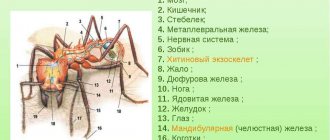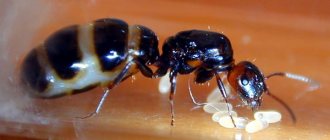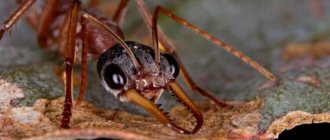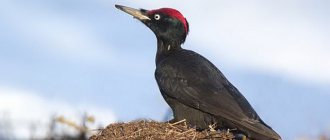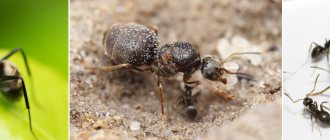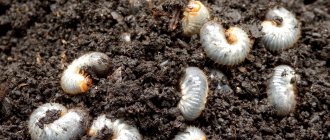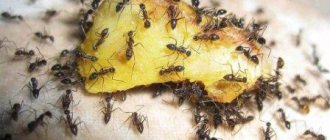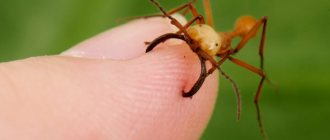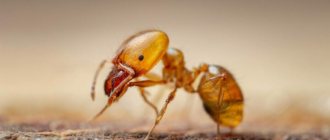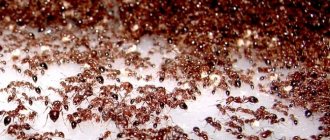Brief description: Description of the main features of ant wintering? How ants overwinter, arrangement of an anthill, food supplies. Features of ant hibernation during the cold season. How do you feel the arrival of heat?
Ants carefully prepare for winter, as this process directly affects their success in surviving the harsh weather conditions of the cold season. In spring, summer and autumn, they expand and deepen their home, storing food supplies, insulating the anthill, not only inside, but also outside.
With the help of an additional top layer of branches and leaves, it is possible to retain heat inside the home. These hardworking insects, when it is still warm, make repairs to their homes, and also take care regarding the release of larval offspring. So, let's figure out how ants winter?
How do ants prepare for the winter?
In order for the ants to have a sufficient amount of food and comfortable wintering conditions, they perform a number of actions, initially they prepare a sufficient amount of food - they collect caterpillars/beetles/bugs/other insects that live in the area, in the forest.
Some of the food is used to feed the larvae, while the rest is stored in special chambers, where they have all the conditions for spending the winter. This allows them to eliminate the need to leave their own “rooms,” thereby preventing the cold from entering the anthill. In addition, their diet includes vegetation, fruits/seeds of garden plants. It is also worth noting such a delicacy as the secretions of live aphids.
The procedure for preparing a house is not complete without insulating it. The ants build a superstructure over the house, forming a dome-shaped mound that provides warmth in winter. It is worth noting that red forest ants make a mound more than one meter wide and 0.5 meters high. This heap contains passages, chambers. Thanks to the collected loose material, the cold cannot get inside.
Adults think about their future legacy, therefore, to preserve the life of the larvae, they are transferred to the warmest possible place and a microclimate that is satisfactory for them, where there will be no sudden changes in temperature.
Bringing out of hibernation
It is necessary to remove the ants slowly so as not to give them hypothermic shock. To do this, gradually raise the temperature over several days, moving the insects to an increasingly warmer place, and to restore strength, prepare protein food for them in advance; a crushed insect is best.
If everything was done correctly, then after a couple of weeks the queen will begin to lay eggs again, which means the wintering was successful. Beginners are still recommended to purchase ants that do without wintering, the types of which are listed in the table at the beginning of the article.
Where do ants go in winter and what happens to them in nature?
The ants remain overwintering in the same anthill as during the rest of the year, the only difference is their movement to chambers located at the depths of the dwelling, where the temperature is higher, most often it is 0 degrees.
A stable temperature regime makes it possible to winter without much loss with a measured way of life. If the first layer gets wet, the workers carry the food supply even deeper. Countries with warm winters allow insects to venture outside to search for food.
Where do they spend the winter?
The chambers where ant larvae overwinter in winter differ from those in summer. Before the onset of cold weather, adult individuals carefully prepare - in order to insulate the house, all holes in it are well sealed with dry grass along with soil. The holes open only for the time when insects need to replenish food supplies. But this is done only when the air temperature rises slightly.
Reading: How to treat an area for mosquitoes: basic methods and rules
If in winter the upper part of an anthill suddenly gets wet, a special rescue squad drags food supplies into deeper compartments. Insects overwinter in their cozy shelter until March-April. A sign that goosebumps will soon surface will be the laying of eggs by the uterus and the gradual resumption of work activity. In spring, the life of adult individuals becomes active and resumes in full.
Where do ants go for the winter? Are they sleeping or not? What do they do, what do they eat?
With the onset of cold weather, colonies slow down the pace of their usual life activities. But this does not mean that they stop performing their duties. The uterus practically does not produce offspring. And the larvae, which do not have time to transform into adults, slow down in development.
The queen is transferred to the warmest chamber, and feeding is also started with foods that are rich in protein, due to which she lays trophic eggs (larvae are not born, in this case the eggs are just food).
In winter, certain types of ants enter diapause (hibernation), during which the work of their internal organs slows down. Some of the species are quietly active, but activity is still slightly reduced when compared to warmer weather conditions.
They require less food. They provide food for the larvae. If the soil temperature rises above 0 degrees, the diapause ends, the insects begin to feed the younger generation and further develop housing.
Those ants that live in mild climates come to the surface when the temperature is above zero, continue to prepare reserves, and breed offspring. They navigate due to the fact that the temperature inside the anthill rises, and the daylight hours decrease or increase.
Larvae that live at high altitudes (state of torpor) are able to survive 2 winters and only after that become adults.
Ant queen
Ants live as a family. This is a highly organized society, consisting of various castes: workers, soldiers, other specialized groups and, of course, queens (reproductive females), of which there may be one or several in one family. In this regard, in ant society there is a division of labor. And it is this fact that has long interested researchers, as it suggests an association with the organization of life in human society.
By the way, many ant families exist for quite a long time: the queen (queen) - up to 20 years, workers - from 1 to 3 years, males - only a few weeks. Many people want to find out what each member of the ant family does? The queen (queen) lays eggs, sometimes she leaves the nest and collects food (this depends on the type of ants).
Males (as in the entire animal world, and there is no exception here) fertilize young females and die after mating. Well, the fate of the males is sad... The third category of members of the ant family is the most numerous and effective - workers. These are mainly females who cannot bear offspring. Since they do all the housework, they differ in size, sensitivity of their sensory organs, and activity.
The queen sometimes leaves the nest when laying eggs.
Their sphere of activity is varied: weaver ants, there are nannies (they look after young individuals), a significant part of the family is engaged in nest construction, forager ants are engaged in prey, there are cleaners, and stock keepers. An ant family can number hundreds of thousands of individuals, but at the same time they all work as a single organism.
We invite you to familiarize yourself with: Raspberry variety Giant, characteristics of agricultural cultivation techniques
And this cannot be surprising. If you decide to find out how ants overwinter in an anthill, then first of all it should be noted that anthills in cold regions are underground, which allows insects to withstand the most unfavorable environmental conditions, including low temperatures. During this period, insects operate in “economy” mode, and the reserves that were collected in the summer are enough for the entire colony.
What does the queen ant look like? In most colonies, the individuals responsible for reproducing offspring are significantly larger in size than ordinary worker insects. The queen can be identified by the presence of wings, which she requires to search for new habitats. However, when moving into a colony, they may disappear. In this case, in the place where the cephalothorax passes into the abdomen, corresponding marks remain in the form of small tubercles.
Why don't ants freeze?
The presented individuals live even in the north, known for cold temperatures. If we talk about Kamchatka and polar ants, their “rooms” are arranged at a depth of up to 30 centimeters.
Those who live in a temperate climate zone are distinguished by the construction of a dome that warms the anthill. When climbing to the upper floors, the ants immediately feel discomfort, which is why they go down.
They survive thanks to special sugary substances secreted by aphids. Accumulating, sugar turns into glycerol in the insect’s body. Therefore, they can easily tolerate even -50 degrees, but plunging into a state of diapause. Initially, you might think that they are dead, since they do not move at all and do not eat food, but this ends immediately with the arrival of warmth.
It is worth noting that in winter, beetles settle in with the ants, which secrete a sweet secretion, which the owners of the house eat, while guests prefer their prepared reserves.
Prevention
Preventive measures are necessary in order to consolidate the achieved effect and prevent further appearance of ants in the house. With their help, you can get rid of insects in your apartment for many years.
For prevention, the following rules must be observed:
- timely remove all leftovers from meals into a trash bin with a tight-fitting lid;
- do not keep large supplies of food in the house;
- Store cereals, flour, sugar and other products in glass jars closed with lids;
- periodically carry out wet cleaning of the premises and prevent the accumulation of trash and debris.
To repel insects, you can use fragrant herbs, aromatic oils and substances with a strong odor. For example, red ants do not like vinegar, ammonia and laundry soap. They also dislike the aroma of cloves and tobacco smoke.
After removing ants, various odors can be used for prevention. Natural herbs that insects do not like:
- garlic;
- sagebrush;
- geranium;
- mint;
- parsley;
- tomato tops.
After removing the ants, fresh plant branches can be laid out near the places where they appear. The disadvantage of this method is that the leaves quickly wither and the smell disappears.
Garlic contains a record amount of essential oils. It can be used to coat baseboards, cracks in the floor and between tiles. The smell will last a long time.
Ants can't stand the smell of garlic
Fresh lemon slices retain their scent longer than herbs. You need to cut the lemon and place the slices in places where arrogant pests are expected to appear.
We suggest you read: What hot peppers can be grown on the windowsill
Geranium can be grown on a window. It blooms beautifully, its smell calms the nervous system. The flower is among the record holders for purifying the air, especially from tobacco smoke. The leaves can be plucked periodically and coated with the exits from ant holes. The disadvantage of removing insects with herbs is that they must be constantly replaced with fresh ones and the ants gradually become accustomed to one smell. Plants need to be changed.
Essential oils retain their scent for a long time. It is enough to drop mint, lemon oil, garlic extract into the hole, the ants will not walk through that tunnel for a long time.
The pungent smell of essential oils will help get rid of insects
In nature, there is a smell that causes panic in ants. This is formic acid. It can be bought at a pharmacy, synthesized artificially. The substance got its name because it is secreted by ants. Insects transmit many signals to each other, producing different enzymes. Some mark the path.
If you buy a bottle of formic acid, the smell of which a person cannot smell, then just apply it to cotton pads and place it along the baseboards, not a single ant will crawl into the apartment. The leftovers can be placed in a cabinet in the kitchen, just do not close it tightly. Let the smell dissipate a little. For a couple of years or more, the apartment is protected from visiting ants.
How long does winter last?
Wintering can last for different periods of time, the main factor influencing this is the climate where the insects live. For example, the species Camponotus sp. It can overwinter for three to five months, but Myrmica sp. 30-60 days are enough; Lasius (Niger) do not hibernate at all of their own accord.
The polar species of ants is distinguished by its wintering period of 8-9 months; the rest of the time they try to feed future heirs, which does not always end successfully, since the region of residence is characterized by a short period of time without snow. Despite this, extreme conditions do not affect their survival.
Those living in warm regions winter during only the two coldest months of the year. The southern inhabitants are lucky, since they rarely hibernate, but despite this, they still prepare for winter, devoting themselves to collecting food, digging tunnels, feeding larvae because of their instincts.
Neighbours
In addition to the ants themselves, aphids, beetles, moths, and also the larvae of these insects also live in their home nearby. They are useful for those who secrete a special nutritious and sweet-tasting enzyme that helps ants survive in the cold. Such neighbors themselves eat not only part of the ant reserves, but also their eggs. Many insects and beetles, hiding from severe frosts, find salvation in abandoned dwellings located on the surface of the soil.
Ants have a big sweet tooth. Sometimes it comes to the point that they carry entire colonies of aphids underground and continue to feast on the sweet secretion secreted. True, without fresh food, aphids die within a few weeks, but for some time the ants have the opportunity to taste the products of their vital activity.
In addition to aphids, other insects also inhabit anthills - beetles, moths and their larvae. They also secrete a sweet juice, and they themselves can feed on ant stores or even their eggs. As a result, they help each other survive in the cold season.
Briefly about the main thing
We found out what ants do in winter. If we are not talking about areas with extreme climates, insects continue to live in their usual mode, but less actively. In northern regions, ants and their larvae overwinter in a supercooled state.
We have found the answer to the question whether ants sleep in winter or not. It turns out that the majority of insects do not sleep. Only some species hibernate.
And one more thing - where are the ants in winter. The answer is quite simple - in your own house, but on the lower floors.
Tags: do, winter, ant, nature
About the author: admin4ik
« Previous entry
Do they sleep at night?
So, the life of an ant colony is in full swing around the clock; at night, individual representatives do not sleep, protecting the anthill and caring for the larvae. It is especially important to protect the colony from various external factors, for example, enemies, natural disasters - floods, fires.
When a threat appears, adults exhibit an immediate reaction, which may differ according to caste. For example, nurse ants strive to immediately move the queen and larvae to a safe place, soldiers prevent an attack on the colony of other insects.
The absence of night rest allows the colony to prevent attacks from other insects and mammals that hunt during this time of day.
The queen or queen also sleeps throughout the day; scientists have not identified the dependence of the duration of her sleep on the period of the day. However, during the cold season, the queens of most ant species sleep - they fall into a state of suspended animation, do not lay eggs, and their food and energy needs are significantly reduced.
Seasonal concerns
Those types of ants that do not hibernate in winter are very sedentary and feed quite rarely. But if the larvae overwinter in the anthill, the adults actively feed them . These types of ants carefully prepare for winter, dragging the larvae into specially designated chambers with a microclimate that is comfortable for them.
To survive the entire winter, working individuals stock up on food in the required quantity in the fall, which should be enough until the snow melts. With the arrival of cold weather, workers begin repairing the anthill, if necessary. They also monitor the maintenance of the microclimate in the chambers of the anthill for a comfortable wintering of the entire population.
After processing
When spraying such purchased products as Combat with Raptor, Clean House, Fumitox and other substances, you should ventilate and clean the foundation as indicated in the instructions. If a decorative layer of plaster or paint is applied to the base, or special slabs are laid, then it is best to wash off the composition after all insects have been destroyed. This will happen approximately within 5 hours.
If there is no decorative coating on the foundation, then you can clean the composition after several days, but it is better not to remove it at all for preventive purposes. Compositions of natural origin, for example, a solution of garlic or potato starch, do not need to be washed off at all. When it rains, it will wash off and be removed from the walls of the building.
Distinctive features
Ants can sleep at any time of the day. Despite the fact that during the night the anthill and the outside world interrupt their connection until the morning (the passages are closed), you need to understand that the life of the colony continues to boil inside. If we take into account sleep in the winter season, then insects that hibernate can remain in suspended animation until it warms up and the snow melts.
Scientists have identified a certain feature: the body of an arthropod, which is in hibernation, continues to function, there is only one difference - a slowdown in all functions and functioning of organs.
Thanks to this, ants can preserve the energy resource of their own body, thereby ensuring the need for less food consumption than at normal times. This specific period is an opportunity for the family to survive prolonged cold weather.
The benefits and harms of ants
Insects can live in a wide variety of ecological zones, so they often conflict with people.
Ants carry aphids, which feed on the sap of various plants and trees, helping to weaken them. Ants can damage agricultural crops, which can lead to the destruction of the entire crop. But there are also benefits from ants. Many people do not even suspect what benefits ants bring, but this is very important. These creatures can destroy an incredible number of caterpillars and other insects that harm crop plants in a season.
The benefits of ants have been fully proven. They cause more than just harm.
Preparing for cold weather
In the life of an anthill, preparation for winter cold is the most important period. Since spring, all the efforts of the colony are concentrated on preparing resources for wintering and the appearance of young animals before the arrival of frost. It is reliably known that many ants in winter do not go into suspended animation , but lead an active lifestyle, although not the same as in the warm season. How they prepare for winter has been studied by both scientific myrmecologists and amateurs. The main stages of preparation for winter are:
- food preparation;
- insulation of the anthill.
When preparing food for food in winter, insects obtain and bring into their home dry fruits, seeds of various plants, as well as dried parts of the plants themselves . Insects drag the prepared provisions from one place to another all winter, which prevents it from deteriorating in conditions of high humidity, and the insects themselves do not die from hunger.
, eggs laid in summer are also a good help . They are sterile (in other words, trophic) and serve as good feeding during the cold season.
The next step is preparing the winter home. Ants move to the lower floors of the anthill , which are located at a depth of 1.5 to 2 meters, where they are quite comfortable. Constant soil temperature at such a depth promotes wintering in fairly good conditions. To insulate the anthill, insects carry various debris and soil out of it to the surface even before the onset of cold weather. This is necessary in order to cover your home with a so-called fur coat. This is how insects prepare for winter.

